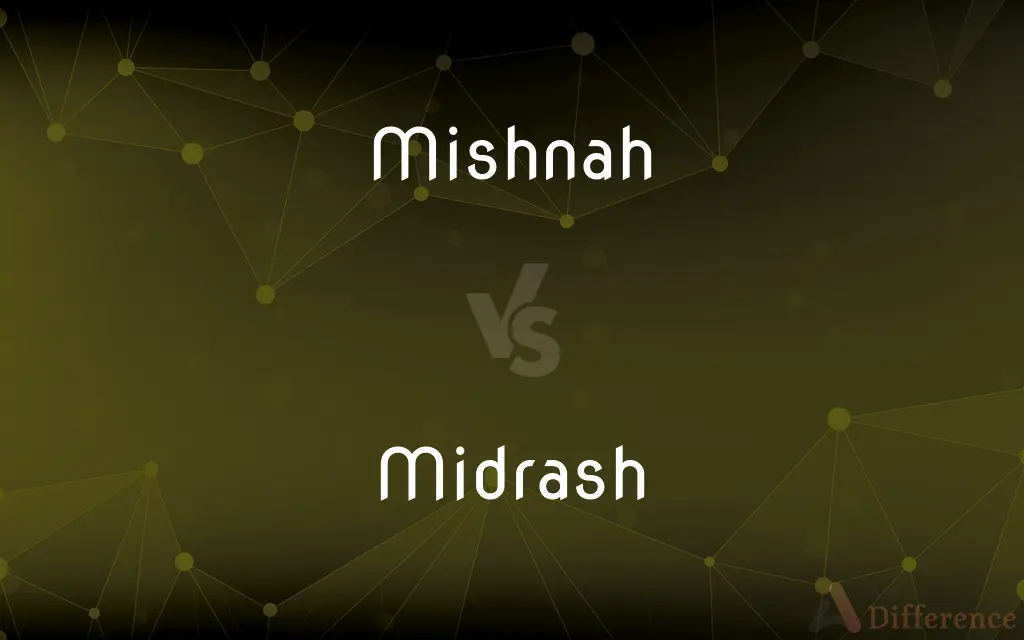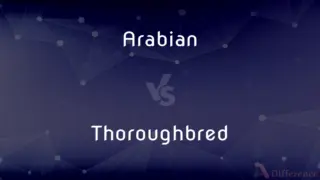Mishnah vs. Midrash — What's the Difference?
Edited by Tayyaba Rehman — By Maham Liaqat — Updated on April 16, 2024
Mishnah is a codified collection of Jewish oral laws, whereas Midrash includes exegetical texts exploring biblical narratives and laws.

Difference Between Mishnah and Midrash
Table of Contents
ADVERTISEMENT
Key Differences
Mishnah organizes Jewish oral traditions into a structured format, systematizing religious duties and everyday legal practices. Whereas Midrash delves deeper into the interpretation of the Hebrew Bible, offering insights and explanations that go beyond the literal text.
Mishnah was redacted by Rabbi Judah the Prince around 200 CE, marking a crucial point in Jewish legal scholarship. On the other hand, Midrash encompasses a broader timeframe and includes collections from both earlier and later periods, reflecting ongoing interpretative processes.
Mishnah is primarily legalistic, focusing on laws applicable to various aspects of Jewish life. While Midrash frequently incorporates narrative elements, using stories and parables to illuminate the biblical texts and commandments.
Mishnah serves as the foundation of the Talmud, which includes extensive discussions and commentaries on its contents. Whereas Midrash is often studied alongside the biblical text to enhance understanding and offer spiritual insights.
Mishnah is more systematic and concise, aiming to provide clear legal guidance. On the other hand, Midrash can be expansive and poetic, exploring themes and moral lessons derived from the scriptures.
ADVERTISEMENT
Comparison Chart
Definition
Codified oral traditions of Jewish law.
Exegetical texts interpreting the Bible.
Origin
Compiled around 200 CE by Rabbi Judah.
Developed over centuries, pre and post 200 CE.
Content Type
Legalistic, focused on laws.
Narrative and exegetical, focused on interpretation.
Primary Purpose
To instruct in religious and legal practices.
To explain and expand upon biblical narratives.
Role in Jewish Studies
Basis for Talmudic study.
Complements biblical study with deeper insights.
Compare with Definitions
Mishnah
Structured into six orders covering different aspects of life.
The Mishnah's orders include topics from agricultural laws to religious festivals.
Midrash
A collection of Jewish biblical exegesis.
Midrash Rabbah explores the deeper meanings behind the stories of Genesis and Exodus.
Mishnah
A codification of Jewish oral law.
The Mishnah organizes laws into orders and tractates for ease of study.
Midrash
Expands upon the narratives and laws in the Hebrew Bible.
Midrashic literature often reveals the ethical lessons underlying biblical events.
Mishnah
Compiled by Rabbi Judah the Prince.
Rabbi Judah's compilation of the Mishnah was a monumental task that preserved Jewish law.
Midrash
Composed over several centuries by various authors.
The Midrash reflects a compilation of insights from different times and places.
Mishnah
The foundational text of the Talmud.
Scholars study the Mishnah alongside the Gemara to fully engage with the Talmud.
Midrash
A tool for spiritual and moral education.
Midrash teachings are used by rabbis to convey moral lessons during services.
Mishnah
A guide for religious and civil conduct.
The Mishnah advises on everything from prayer rituals to civil disputes.
Midrash
Utilizes parables and stories for interpretation.
Midrash includes imaginative accounts that elucidate biblical figures' actions.
Mishnah
The Mishnah or the Mishna (; Hebrew: מִשְׁנָה, "study by repetition", from the verb shanah שנה, or "to study and review", also "secondary") is the first major written collection of the Jewish oral traditions which is known as the Oral Torah. It is also the first major work of rabbinic literature.
Midrash
Midrash (; Hebrew: מִדְרָשׁ; pl. מִדְרָשִׁים midrashim) is expansive Jewish Biblical exegesis using a rabbinic mode of interpretation prominent in the Talmud.
Mishnah
The first section of the Talmud, being a collection of early oral interpretations of the scriptures as compiled about AD 200.
Midrash
Any of a group of Jewish commentaries on the Hebrew Scriptures compiled between AD 200 and 1200 and based on exegesis, parable, and haggadic legend.
Mishnah
A paragraph from this section of the Talmud.
Midrash
A talmudic exposition of the Hebrew law, or of some part of it.
Mishnah
The teaching of a rabbi or other noted authority on Jewish laws.
Mishnah
The first part of the Talmud; a collection of early oral interpretations of the scriptures that was compiled about AD 200
Common Curiosities
What is the Midrash?
The Midrash refers to a variety of exegetical texts that interpret and expand upon the Hebrew Bible.
Who compiled the Mishnah?
The Mishnah was compiled by Rabbi Judah the Prince in the early 3rd century CE.
Why is the Midrash important for Jewish studies?
The Midrash provides cultural and historical context, enriching the study of the Hebrew Bible.
What is the Mishnah?
The Mishnah is the written form of Jewish oral traditions, focusing on laws and regulations.
How do the Mishnah and Midrash differ in purpose?
The Mishnah aims to codify Jewish law, while the Midrash seeks to elucidate and interpret biblical stories and commandments.
Can the Midrash be found in a single collection?
No, the Midrash is not a single book but a collection of various works compiled over time.
How are laws presented in the Mishnah?
Laws in the Mishnah are organized systematically by topics, such as Sabbath laws and dietary rules.
Is the Mishnah part of the Talmud?
Yes, the Mishnah forms one part of the Talmud, alongside the Gemara.
What types of stories are found in the Midrash?
The Midrash includes a range of stories, from allegorical tales to historical narratives, all aimed at deepening understanding of the scriptures.
Are there different types of Midrash?
Yes, there are two main types: Midrash Halacha (legal discussions) and Midrash Aggadah (narrative and theological discussions).
What is the structure of the Mishnah?
The Mishnah is divided into six orders, each focusing on a different aspect of Jewish law and life.
How does the Midrash influence Jewish thought?
The Midrash influences Jewish thought by offering diverse interpretations that inspire theological and ethical reflections.
When was the Mishnah considered complete?
The Mishnah was considered complete around the year 200 CE.
How does the Mishnah impact modern Jewish practice?
The Mishnah directly impacts modern Jewish practice by providing the foundational laws that guide religious life and rituals.
Do all Jewish denominations study the Midrash?
While most Jewish denominations reference the Midrash, the depth and manner of study can vary.
Share Your Discovery

Previous Comparison
Intend vs. Want
Next Comparison
Arabian vs. ThoroughbredAuthor Spotlight
Written by
Maham LiaqatEdited by
Tayyaba RehmanTayyaba Rehman is a distinguished writer, currently serving as a primary contributor to askdifference.com. As a researcher in semantics and etymology, Tayyaba's passion for the complexity of languages and their distinctions has found a perfect home on the platform. Tayyaba delves into the intricacies of language, distinguishing between commonly confused words and phrases, thereby providing clarity for readers worldwide.
















































